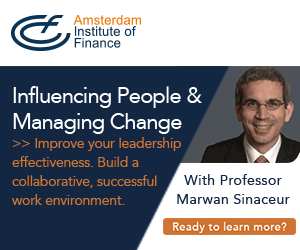How can Finance demonstrate its added value? Five tips from Sean Boyle, CFO of AWS.
Directors don’t always see the financial team as a strategic partner. They might be great as a supplier of figures, necessary as the holders of the purse strings, and sometimes a nice excuse to nip ambitious plans in the bud. But not really a partner who deserves an equal vote in the Board room. You could call this point of view old-fashioned, but Finance itself has an important task in demonstrating its strategic value. How? On the one hand by supplying the indispensable foundation of the strategy, and on the other hand by adopting a more strategic and innovative attitude.
Traditionally, Finance mainly focused on controlling costs. But thanks to new technologies that not only collect data, but also connect and analyze, deeper insights are created that far exceed the process of the pluses and the minuses.
And the more Finance knows, the more it can contribute to the strategic course of the company. Data that previously only came to the table when reporting can now be made available real-time to the business partners within the company. There is a direct line from Finance to operations, sales, customer service and back again to strategy and policy. This enables the business partners to make well-founded decisions and to be able to develop activities that directly contribute to the success of the company.
Conversely, operational decisions that are not based on current financial data lead to a decline in profitability, according to the Gartner study “Drive Financially Sound Operational Decisions” (pdf)
Five tips from Sean Boyle, CFO of AWS
The role of Finance within the organization is undeniably changing. This is due to new technologies that provide better and deeper financial insights. This not only requires a different attitude of the directors and business partners within the organization, Finance itself must also adapt to the new role in the strategy and innovation of the company. During the annual meeting of The Wall Street Journal CFO Network, Sean Boyle, CFO of Amazon Web Services (AWS), gave a good insight into how he approaches this within his team. Boyle shared five tips and I am happy to pass them on.
1. Start small
In an innovation process it is wise to start with small teams. Boyle uses the ‘two pizzas’ philosophy for this. The ideal team doesn’t eat more than two pizzas in one meeting. Boyle: “Start investing in small-scale, switch quickly if things go well, but also ensure a ‘failing fast’ concept.” If a component fails, ensure the team can immediately switch back to the point where the model worked and yielded the desired results.
2. Take an example from the business
“We have a financial structure that reflects the business team,” says Boyle. “My employees are deeply involved in the business. I make sure that the people operate more or less like the COO of their field and that they are virtually indistinguishable from their discussion partners in a business meeting, except that they naturally understand a great deal about their own area: finance. “
3. Trust your team
“Give them the freedom to try out new things. My basic attitude is not: just prove it first. In principle I say ‘yes’, but I want them to be able to substantiate the position or proposed action. I am a CFO-go, rather than a CFO-no. The goal is to be able to help the business teams quickly. “
“Give them the freedom to try out new things”
Sean Boyle, CFO of AWS
4. Look beyond the accounting
Boyle has hundreds of people in his financial team, with many different skills. “Our organization has grown enormously and this brings in new skills. The team not only includes accounting and financial experts, but also MBAs, engineers, data scientists, software developers and business intelligence specialists. Our experience is that if you have a broad range of have competencies and knowledge, you can support the business in a much more valuable way and you can scale up much more easily. ”
5. Bring ideas out quickly
“AWS has a full and genuine dedication to customers,” says Boyle. The customer dedication has an impact on everything from recruitment of new employees to forming new ideas. One way AWS feeds and maintains customer focus is through a PR / FAQ process. Teams write new ideas in press releases and FAQs. By articulating their ideas in an understandable story and by addressing possible questions and objections in advance, the idea will become much better and more concrete.
By Rob Cools, Product Marketing Director at Workday
